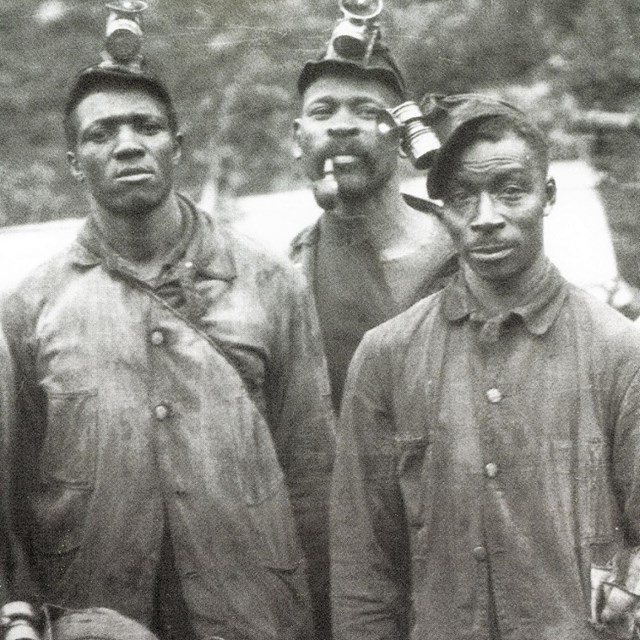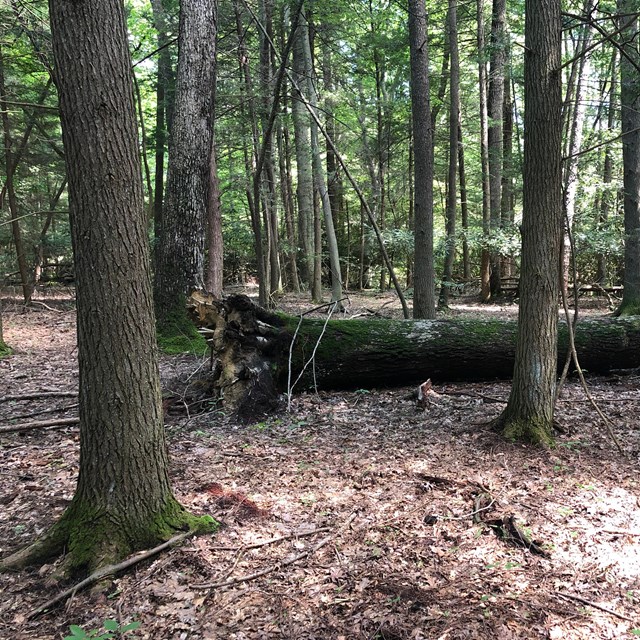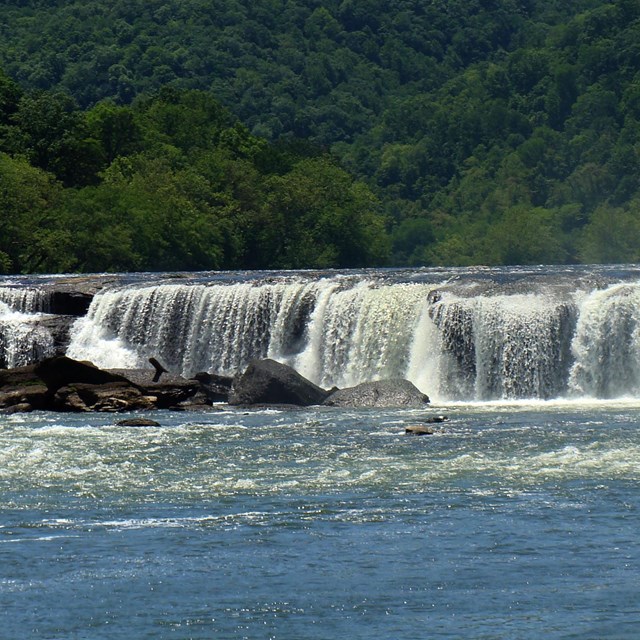
NPS / Louise McLaughlin Tour of the TownWhat remains of Thurmond helps give us a sense of the spirit of this place during its heyday. Each building added to the rich fabric of this community. Take this tour and learn the story of Thurmond, a place that was truly the heart of the New River Gorge. The tour is also available on the NPS Mobile App. This walking tour is 0.5 miles roundtrip and takes about 1 hour to complete. The walk through town is over flat, but uneven pavement, bricks, and gravel. Please use extra caution when crossing the road and railroad line in town. This track is still active CSX mainline. Many freight trains pass through Thurmond daily. Cross only at the designated railroad crossing and do not walk on the tracks. 
NPS 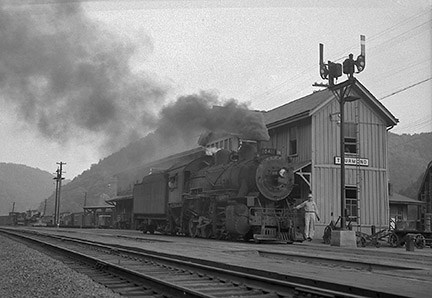
Gene Huddleston; C&O Historical Society 1. Passenger DepotThe first passenger depot built in 1897 burned down only a few years later in 1903. The Chesapeake and Ohio Railway announced the new depot would be one of the largest on the line. The new two-story Thurmond Depot opened in 1904. The first floor served travelers coming and going from Thurmond. The ticket agent’s office, baggage room, waiting rooms, and restrooms were at track level. Other services for passengers on the first floor included a snack and news room. The second floor housed the signal tower and telegraph office. It also had offices for the dispatcher, train master, and conductor. The decline in passenger trains in the 1960s caused the depot to undergo changes. The entire first floor joined the second floor as offices for the railroad. These offices operated until the mid-1980s when they finally closed. A few years later, the National Park Service acquired the depot. The park service restored the building to its classic early 1900s look. In 1995, the building opened for use as a visitor center. Today, this place gives us a glimpse of Thurmond’s lively days. Active preservation work continues to maintain its historical appearance. Thurmond remains a flag stop for Amtrak passenger trains. Amtrak added an accessibility platform in 2023. 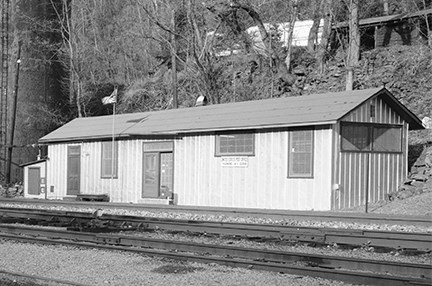
NPS 2. CommissaryIn 1929, Fitzgerald & Company built a commissary on land leased from the C&O Railway. The commissary provided food and supplies to railroad workers in Thurmond. Part of workers’ paychecks could be set aside for food and supplies from the commissary. Unlike the stores of the coal company towns, this was optional. Workers were not forced to buy from the commissary. The first post office in Thurmond opened in 1888. For years it operated out of the Thurmond Hotel. In 1963, after fire destroyed the hotel, the U.S. Post Office moved into the old commissary building. The post office served the town of Thurmond until 1995 when it finally closed its doors. In the late 1990s, the last business in Thurmond operated out of the old post office. Thurmond Supply rented bicycles and sold ice cream to visitors. It closed after only a few years. The building is currently privately owned. 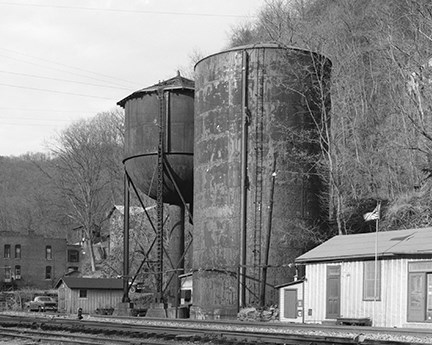
NPS 3. Water Tank FoundationsThurmond was more than a railroad town, it was a steam town. The steam locomotives of Thurmond constantly needed water. In 1914, the C&O Railway built an elevated steel tower water tank with a 100,000 gallon capacity. In 1927, they added a steel standpipe water tank that held 210,000 gallons of water. Both tanks served five water columns, pipes used to fill steam locomotives with water. The tanks also provided water to the engine house and the fire hose house. In the 1950s, many railways began switching from steam locomotives to diesel locomotives. Diesel locomotives do not have the water requirements of their steam counterparts. Water columns were no longer needed. CSX Transportation, modern-day C&O Railway, removed the tanks in 1998. All that remains of the water tanks are the cement foundations. 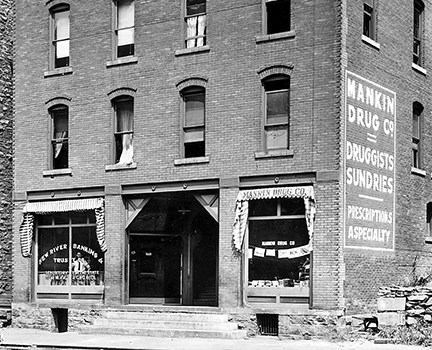
NPS 4. Mankin-Cox BuildingThe Mankin-Cox Building marks the southern most point of downtown Thurmond. The town added the commercial district because of the income coming into Thurmond. In Thurmond, the C&O Railway was making millions of dollars in the early 1900s to 1910s. In 1904, Dr. J. W. Mankin built the Mankin-Cox building. He ran his medical practice on the second floor on the right side of the building. On the first floor, his wife operated the Mankin Drug Company. She had her degree in pharmaceuticals and mixed medications for patients. The drug store also sold toiletries, magazines, and other sundries, or miscellaneous items. On the left side of the building was the New River Banking and Trust Company. It was one of two banks that operated in Thurmond during the boom years. After years of service in Thurmond, the bank moved to Oak Hill, West Virginia. The Mankin-Cox building had many other businesses in it over the years. These included a dentist office, pizza parlor, and arts and crafts shop. 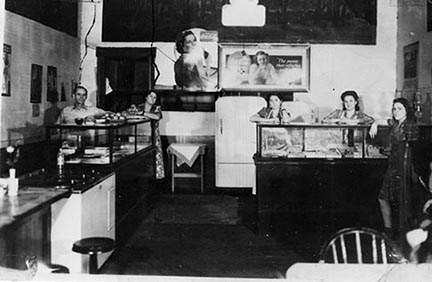
NPS 5. Goodman-Kincaid BuildingStandard Dry Goods Company built the Goodman-Kincaid building around 1906. This large structure is the largest building along Commerical Row. The second floor had several offices for businesses including a lawyer. Chesapeake and Potomac Telephone Exchange Company had its office there as well. In Thurmond, there wasn't much flat land at the bottom of the gorge. The railroad used most of this land for tracks, rail yards, and other infrastructure. Building houses on the side of the gorge was difficult. With a population of 300 to 500 people, most residents didn't live in houses. Instead, they lived in apartments over the businesses. Most of the upper floors of the Goodman-Kincaid building were apartments. The first floor had several restaurants and shops over the years. The most famous restaurant was the Homestead Restaurant. Mrs. Ida McClure owned the Homestead and cooked meals for railroad workers. During World War II, she did her part for the war effort by serving free meals to soldiers on troop trains. Her restaurant closed in 1945 at the end of the war. 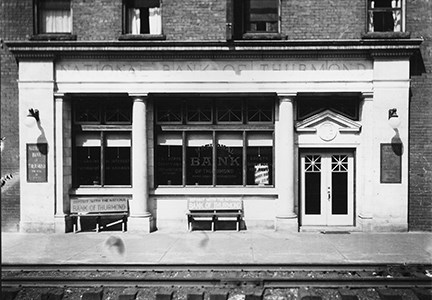
NPS 6. National Bank of ThurmondIn 1917, Bullock Realty Company completed construction of the Bank Building. For the first 6 years, the Bank Building was home to a jewelry store and clothing store. The upper floors were offices and apartments for Thurmond residents. For several years, Western Union Telegraph Company had its office in the building. In 1923, as the name suggests, the Bank of Thurmond moved into the Bank Building. For years the bank operated in the Hotel Thurmond before moving into its final location. Only a few years later, in 1931, the bank failed during the Great Depression. After the bank closed, a dry good store opened and operated for many years. In the 1970s, Thurmond residents Erskine and Jacqueline Pugh bought the Bank Building. Together with the other buildings on Commerical Row, they created the Banker's Club. The Banker's Club was a hotel, restaurant, and club which served whitewater rafters. People from all over the world came to raft the New River and stay in Thurmond. The Banker's Club closed in 1988. 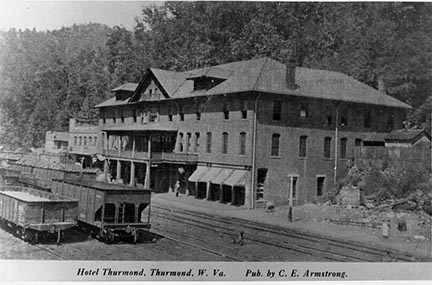
C&O Historical Society 7. Lafayette HotelThe first Hotel Thurmond burned down but was quickly replaced by a new hotel in 1902. The new hotel, known as the Lafayette Hotel, had thirty-five rooms and seven bathrooms. The hotel also boasted steam heat and four hundred electric lights. The dining room could hold sixty people. The Lafayette Hotel was not without competition. The Dunglen Hotel located across the river competed with the hotel in Thurmond. The Dunglen is best known for allegedly being the home of a fourteen-year long poker game. Although it is unclear when or even if this actually occured. Its luxury and entertainment activities contributed to earning the town the nickname “Dodge City of the East.” The Dunglen burned down in 1930. Besides serving as a hotel, the Lafayette Hotel also had several business and shops. A jewelry store and barber shop operated in the hotel. For many years, it was also home to the post office and Bank of Thurmond. Tragically, the hotel burned down in 1963. Only the back brick wall of the hotel remains. 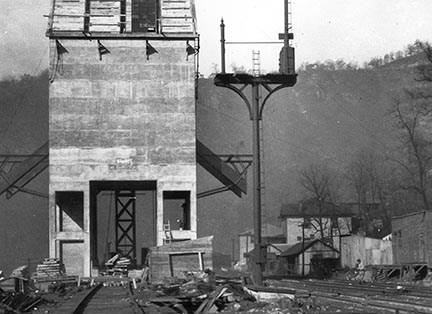
C&O Historical Society 8. Coaling TowerThe C&O Railway built this large cement coaling tower in 1922. It held as much as five hundred tons of coal. A series of elevators lifted coal into the tower. Tracks on either side of the tower allowed locomotives to move close to the chutes. The coal fell down the chutes into the waiting tenders of the locomotives. The cement building next to the coaling tower is the sanding house. Locomotives used sand to grip slippery rails. In the wet and sometimes steep New River Gorge, sand was useful to help locomotives up the grades. At the coaling tower, as locomotives filled up with coal, they also resupplied their sand. After the switch to diesel electric locomotives, the coaling tower was not needed. The C&O Railway abandoned the coaling tower in 1960. It is still owned by modern day CSX Transportation. 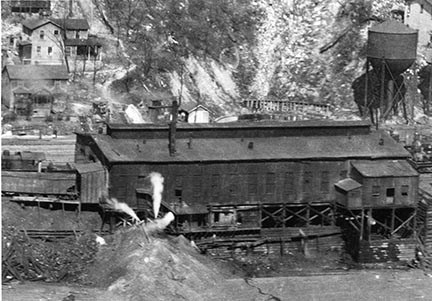
NPS 9. Engine HouseThroughout its history, many of Thurmond's residents worked for the C&O Railway. The Engine House was the heart of the railroad. Although rectangular in shape, it was the same as a roundhouse. It served as the repair shop for locomotives and railcars. Built in 1905, the Thurmond Engine House was the workplace of 50 to 70 men. At its peak, 175 men worked round the clock in 3 shifts. Each shift lasted 8 hours. At peak operation, the Engine House serviced 60 to 100 railcars daily. Machinists, boilermakers, and steam fitters worked hard to maintain locomotives. At any given time, 2 to 3 locomotives were being serviced. The Engine House kept 2 to 3 more locomotives steamed up, ready to go at a moment's notice. The switch to diesel electric locomotives made the Engine House obsolete. In 1963, the Engine House closed and an auto repair shop opened in its place until 1985. The abandoned Engine House burned in 1993. More Self-Guided Tours
|
Last updated: August 24, 2025

